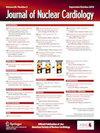Prognostic value of transient ischemic dilation on Rubidium-82 positron emission tomography myocardial perfusion imaging
IF 2.7
4区 医学
Q2 CARDIAC & CARDIOVASCULAR SYSTEMS
引用次数: 0
Abstract
Background
Transient ischemic dilation (TID) of the left ventricular (LV) cavity is considered a high-risk marker in patients with abnormal single photon emission computed tomography (SPECT) myocardial perfusion imaging (MPI). Stress image acquisition with rubidium-82 (82Rb) PET occurs at peak stress compared to 30–60 minutes post-stress with SPECT. We aimed to evaluate the prognostic value of TID in patients undergoing 82Rb PET MPI.
Methods
A total of 9878 consecutive patients with LVEF ≥40% undergoing rest/pharmacologic stress 82Rb PET MPI from 2010 to 2016 were followed for a median of 3.2 years. The primary clinical outcome of cardiac death was assessed after adjusting for pre-test risk, known coronary artery disease (CAD), resting left ventricular ejection fraction (LVEF), summed stress score (SSS), LVEF reserve (LVEF-R), myocardial blood flow reserve (MBFR), and early (90-day) revascularization. Pre-specified interactions between TID and SSS were included to assess potential differences in the prognostic value of TID in patients based on perfusion.
Results
The mean age of the cohort was 69.0 (11.7) years with 56.1% being female, 49.8% having known CAD, and 27.9% having abnormal perfusion (SSS>0). There were 451 cardiac deaths. Higher TID ratios were associated with higher risk of cardiac death, even after accounting for LVEF-R and MBFR (HR per .1 unit increase = 1.25 (1.11, 1.41), P < .001). This was seen in patients with both normal (HR for TID per .1 unit increase = 1.24 (95% CI: 1.01, 1.52), P = .04) and abnormal perfusion (HR for TID per .1 unit increase = 1.14 (95% CI: 1.02, 1.28), P = .03).
Conclusions
TID on rest/stress 82Rb PET MPI offers independent prognostic value in patients with both normal and abnormal perfusion independent of other risk factors in patients with LVEF ≥40%.
铷-82正电子发射断层扫描心肌灌注成像中短暂缺血扩张的预后价值
理由:单光子发射计算机断层扫描(SPECT)心肌灌注成像(MPI)异常患者的左心室(LV)腔一过性缺血扩张(TID)被认为是一种高危标志物。铷-82(82Rb)PET 的应激图像采集是在应激高峰期进行的,而 SPECT 是在应激后 30-60 分钟进行的。我们的目的是评估 TID 在接受 82Rb PET MPI 患者中的预后价值:2010-2016年间,共有9878名LVEF≥40%的连续患者接受了静息/药物应激82Rb PET MPI检查,随访时间中位数为3.2年。在对测试前风险、已知冠状动脉疾病(CAD)、静息左室射血分数(LVEF)、应激总分(SSS)、LVEF储备(LVEF-R)、心肌血流储备(MBFR)和早期(90天)血管再通进行调整后,对心源性死亡这一主要临床结局进行了评估。预先指定的TID比率与SSS之间的交互作用也包括在内,以评估基于灌注的TID对患者预后价值的潜在差异:组群的平均年龄为 69.0 (11.7)岁,56.1% 为女性,49.8% 有已知的 CAD,27.9% 有异常灌注(SSS>0)。即使考虑到 LVEF-R 和 MBFR(每增加 0.1 个单位的 HR =1.25 (1.11, 1.41),p),TID 比率越高,心脏性死亡的风险也明显越高:在 LVEF >40% 的患者中,静息/压力 82RbPET MPI 的 TID 对灌注正常和异常的患者具有独立的预后价值,超过了其他风险指标。
本文章由计算机程序翻译,如有差异,请以英文原文为准。
求助全文
约1分钟内获得全文
求助全文
来源期刊
CiteScore
5.30
自引率
20.80%
发文量
249
审稿时长
4-8 weeks
期刊介绍:
Journal of Nuclear Cardiology is the only journal in the world devoted to this dynamic and growing subspecialty. Physicians and technologists value the Journal not only for its peer-reviewed articles, but also for its timely discussions about the current and future role of nuclear cardiology. Original articles address all aspects of nuclear cardiology, including interpretation, diagnosis, imaging equipment, and use of radiopharmaceuticals. As the official publication of the American Society of Nuclear Cardiology, the Journal also brings readers the latest information emerging from the Society''s task forces and publishes guidelines and position papers as they are adopted.

 求助内容:
求助内容: 应助结果提醒方式:
应助结果提醒方式:


